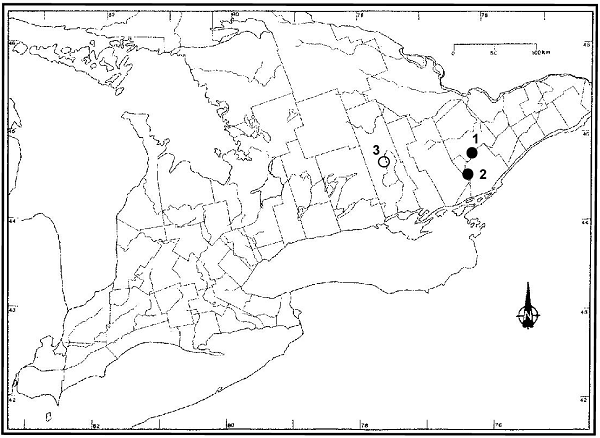Ogden's Pondweed (Potamogeton ogdenii) COSEWIC assessment and status report: chapter 4
Distribution
Global range
Ogden’s pondweed is a globally rare species that occurs in lakes, ponds, and slow-moving streams in southern Ontario (2 current and 1 historic sites), western Connecticut (2 current and 3 historic sites), central New York (3 current and 2 historic sites), central Vermont (2 current and 2 historic sites), and western Massachusetts (2 current sites) (Figure 1). Globally, there are 11 populations considered current or extant plus eight historic populations.
Figure 1. North American distribution of Potamogeton ogdenii (after FNA, 2000).

Canadian range
In Canada, Ogden’s pondweed is found only in southeastern Ontario (Figure 2). The first collection was made in 1873 by John Macoun but due to the vague locality of “Hastings County”, this site is plotted in the centre of the county on Figure 2 (site 3). Only two other locations are known. These were collected at Murphys Point Provincial Park (site 1) in 1974 and at Davis Lock on the Rideau Canal (site 2) in 1987 (Appendix 1). If the Hastings County site is included and assumed to be in the central part of the county, the total extent of occurrence (EO) is 1000 km². According to C.B. Hellquist (pers. com., March 2006, to B. Bennett, COSEWIC Plants Subcommittee) there are no additional Canadian records.
Figure 2. Distribution of Potamogeton ogdenii in Canada. Solid dots represent possibly extant populations recorded after 1970. The open circle is the 1873 record plotted in the centre of Hastings County.

The treatment of Ogden’s pondweed in FNA (2000) lists only the 1987 collection from Ontario. Although the 1974 collection from Murphys Point is not listed in FNA (2000), the specimen was identified by C.B. Hellquist in 1985 and accepted in Hellquist (1985). The omission of the Murphys Point record from FNA (2000) is probably just an inadvertent error. The 1873 record from Hastings County is not listed in FNA (2000) either because of its age or due to the vague locality; however, the specimen was identified by C.B. Hellquist and the record is noted in Hellquist & Mertinooke-Jongkind (2003).
Considering the similarity between Ogden’s pondweed and the other eight linear-leaved species in the province, it is likely that Potamogeton ogdenii has been overlooked and could be less rare within its presently-known range or more widespread in Ontario than is currently known. Nonetheless, pondweeds have been widely collected across southern Ontario. Major herbaria, such as DAO (the official acronym for the herbarium at the Central Experimental Farm, Agriculture and Agrifood Canada, Ottawa), contain thousands of Potamogeton specimens from the province. At DAO, the vast majority of these collections have been identified or verified by such pondweed experts as C.B. Hellquist or R.R. Haynes. Amongst all these DAO pondweed specimens, only one has been determined to be Potamogeton ogdenii--the 1987 collection from Davis Lock (specimen shown in Figure 3). Since Ogden’s pondweed is probably of hybrid origin between P. hillii and P. zosteriformis, it might be assumed that Ogden’s pondweed would occur where the ranges of the two parents overlapped. Although P. zosteriformis is quite widespread in Ontario, P. hillii is restricted primarily to Manitoulin Island and the Bruce Peninsula--a long distance from the known sites of Ogden’s pondweed. At most locations in the US, however, Ogden’s pondweed is found only with one of the parents, P. zosteriformis (Hellquist & Mertinooke-Jongkind, 2003).
Figure 3. Specimen of Potamogeton ogdenii from Davis Lock (photo of collection at the Department of Agriculture, Ottawa (DAO)).

Although there has been considerable collecting of Potamogeton species within the apparent range of Ogden’s pondweed in the province, no comprehensive surveys have been undertaken and until such intensive sampling is done, the Ontario distribution of Ogden’s pondweed (and other narrow-leaved species of Potamogeton) should be considered tentative.
Page details
- Date modified: